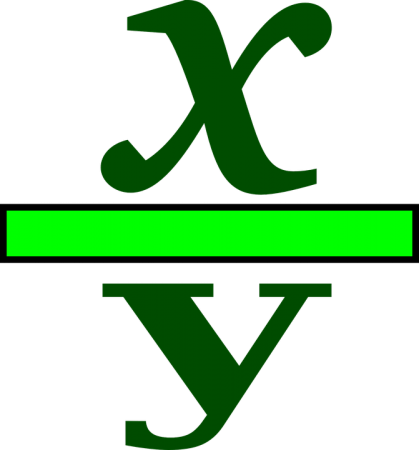
In the context of mathematics, a rational number is a number that can be expressed as the ratio of two integers. A rational number is a number that is equal to the quotient of two integers p and q. In other words, a rational number can be expressed as some fraction where the numerator and denominator are integers. Some examples of rational numbers include:
- The number 8 is rational because it can be expressed as the fraction 8/1 (or the fraction 16/2)
- the fraction 5/7 is a rational number because it is the quotient of two integers 5 and 7
- the decimal number 1.5 is rational because it can be expressed as the fraction 3/2
- the repeating decimal 0.333… is equivalent to the rational number 1/3
Traditionally, the set of all rational numbers is denoted by a bold-faced Q. Rational numbers are distinguished from the natural number, integers, and real numbers, being a superset of the former 2 and a subset of the latter. There also exist irrational numbers; numbers that cannot be expressed as a ratio of two integers. An example of an irrational number is √2. √2 cannot be written as the quotient of two integers.
Let’s take a step back and talk about the different kinds of numbers.
Kinds Of Numbers
It may come as a surprise to some that there exist different classes of numbers. After all, a number is a number, so how can some numbers be fundamentally different than other numbers? In a nutshell, numbers can be differentiated by how they behave when being added, subtracted, multiplied, or divided.
Natural Numbers

Credit: Good Free Photos CC0 1.0
Let’s start with the most basic group of numbers, the natural numbers. The set of natural numbers (denoted with N) consists of the set of all ordinary whole numbers {1, 2, 3, 4,…} The natural numbers are also sometimes called the counting numbers because they are the numbers we use to count discrete quantities of things. A key feature of natural numbers is that they can be represented without some fractional or decimal component. There are an infinite amount of natural numbers stretching from 1 to infinity.
The natural numbers are considered the most basic kind of number because all other kinds of numbers can be defined as extensions of the natural numbers. Traditionally, the natural numbers do not contain the number zero (0), though some mathematicians consider 0 to be a natural number.
The natural numbers are closed under addition and multiplication. This means that if you add or multiply any two natural numbers, your answer will be another natural number. Adding 4 and 4 gives equals the natural number 8 and multiplying 5 by 1,000,000 equals the natural number 5,000,000. Adding or multiplying two natural numbers will always give you another natural number, no exceptions.
What about subtraction though? The natural numbers are not closed under subtraction. This means that if you subtract two natural numbers, your answer may not always be a natural number, which leads us to…
Integers
Next up are the integers. The integers (denoted with Z) consists of all natural numbers and all negative whole numbers (…-4, -3, -2, -1) The set of integers is constructed by adding the additive inverse of every natural number, so it contains all positive and negative whole numbers {…-4, -3, -2, -1, 0, 1, 2, 3, 4,…}. As a consequence, all natural numbers are also integers. Like the naturals, there are an infinite amount of integers spanning from negative infinity to positive infinity.

Credit: WikiCommons CC0 1.0
Like the natural numbers, the integers are closed under addition and subtraction. Adding or multiplying any two integers will always give you another integer. Introducing negatives into our number systems makes it so that the integers are also closed under subtraction. Subtracting any two integers will always give you another integer. 6−3 = -3 and 12−40 = -28.
Now we have a set of numbers that is closed under addition, multiplication, and subtraction. What about division though? A moment’s thinking should tell you that no, the integers are not closed under division. Dividing two integers may not always result in another integer. This realization leads us to the next set of numbers…
Rational Numbers

Credit: Pixabay CC0 1.0
Enter the rational numbers. The addition of rational numbers (denoted Q) allows us to express numbers as the quotient of two integers. Every rational number can be uniquely represented by some irreducible fraction. The number 3/2 is a rational number because it is expressed as a fraction in simplest form. Consequently, the rational number 6/4 is also equal to 3/2, because 6/4 can be simplified to 3/2. All integers (and so all natural numbers) can be expressed as an irreducible fraction (8 = 8/1 and -5 = -5/1), so all integers and natural numbers are also rational numbers.
Rational numbers are added to the number system to allow that numbers also be closed under division (with the lone exception of division by 0). The quotient of any two rational numbers can always be expressed as another rational number. This insight can be seen in the general rule for dividing fractions (i.e. rational numbers).
a/b ÷ c/d = ad/bc when d and b ≠ 0
a/b and c/d are rational numbers, meaning that by definition a, b, c, and d are all integers. Since the integers are closed under multiplication, ad and bc are also integers. ad/bc is represented as a ratio of two integers, which is the exact definition of a rational number. Therefore, the rational numbers are closed under division.
Rational numbers can also be expressed as decimals. Converting from fraction to decimal notation is easy: all you have to do is set up a long division problem and divide the numerator by the denominator. Dividing out an irreducible fraction will give you one of two results: either (i) long division will terminate in some finite decimal sequence or (ii) long division will produce an infinitely repeating sequence of decimals (e.g. 1/3 = 0.333… and 6/11 = 0.5454…).
Converting from a decimal to a fraction is likewise easy. All you have to do is multiply the decimal by some power of 10 to get rid of the decimal point and simplify the resulting fraction.
eg) 0.25 × 100/100 = 25/100 = 1/4
The rational numbers are the simplest set of numbers that is closed under the 4 cardinal arithmetic operations, addition, subtraction, multiplication, and division. This property makes them extremely useful to work with in everyday life. Rational numbers are not the end of the story though, as there is a very important class of numbers that cannot be expressed as a ratio of two integers.
Irrational Numbers
An irrational number is a number that cannot be expressed as a ratio of two integers. Irrational numbers cannot be represented as a fraction in lowest form. The two sets of rational and irrational numbers are mutually exclusive; no rational number is irrational and no irrational number is rational. Common examples of irrational numbers include π, Euler’s number e, and the golden ratio φ. None of these three numbers can be expressed as the quotient of two integers.
How do we even know irrational number exist? Here is a simple proof by contradiction which shows that √2 is an irrational number:
Assume √2 is a rational number. If √2 is a rational number, then that means it can be expressed as an irreducible fraction of two integers. Let’s call those two integers p and q.
(1.) √2 = p/q
Since p/q is an irreducible fraction (per the definition of a rational number) they do not have any factors in common. Squaring both sides to get rid of the left hand radical gives us:
(2.) 2 = p2/q2
which we can rearrange into:
(3.) 2q2 = p2
This result implies that p2 is an even number because 2 is one of its factors. The only way p2 could be even is if p itself is even. If p is even, then there is some number k such that p = 2k. Substituting 2k for p in equation (3.) gives us:
(4.) 2q2 = (2k)2
(5.) 2q2 = 4k2
Equation (5.) can be rewritten as:
(6.) q2 = 2k2
By similar reasoning, q2 and q must be even. Therefore, both p and q are even numbers. However, this contradicts our requirement from (1.) that p and q do not share any factors. Since we derived a contradiction, our initial assumption (that √2 is rational) must be false. Therefore, √2 is an irrational number and cannot be expressed as the quotient of two integers.
Irrational numbers rear their head all over the place. As it turns out, the square roots of most natural numbers are irrational. Many commonly seen numbers in mathematics are irrational. For example, the number π which is the ratio of the diameter of a circle to its circumference is irrational Additionally, Euler’s number e, the unique number whose natural logarithm is 1, is also irrational.
For some time, it was thought that all numbers were rational numbers. The preoccupation with rational numbers stems back to ancient Greece with the teaching of the Pythagoreans. The Pythagoreans were a quasi-religious sect who believed that numbers are the basic constituents of the universe. Central to their beliefs was the idea that all quantities could be expressed as rational numbers. The legend goes that the Pythagorean Hippasus first discovered the existence of irrational numbers when trying to solve for the hypotenuse of a right triangle with sides of equal length. Hippasus discovered that the length of the hypotenuse could not be understood as proportional to the lengths of its sides, and in doing so discovered irrational numbers. Reportedly, his discovery so greatly distressed the other Pythagoreans that they had Hippasus drowned as punishment for sacrilege.
Nowadays, we understand that not only do irrational numbers exist but that the vast majority of numbers are actually irrational. Comparatively, the set of rational numbers (which includes the integers and natural numbers) is incomprehensibly dwarfed by the size of the set of irrational numbers.
To sum up, rational numbers are numbers that can be expressed as the quotient of two integers. Rational numbers form an important class of numbers and are the simplest set of numbers that is closed under the 4 cardinal arithmetic operations of addition, subtraction, multiplication, and division. Rational numbers are distinguished from irrational numbers; numbers that cannot be written as some fraction.









